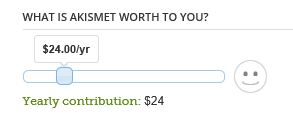Emotion can be loosely defined as “a response to stimuli that involves physiological changes, which motivate a person to act.” Advertisers and marketers intrinsically understand the power of emotion to move people to purchase, donate, and even volunteer. But advertisers aren’t the only ones that draw on the power of emotion in everyday communication. In an era of instant messaging and texting, emoticons are being used to quickly convey sentiment and emotion within a medium where text is too constrained to do the job. In essence, emoticons are a shortcut to transmitting emotion to others. Along those lines, the use of emoticons to convey sentiment and also drive action is an area I’m referring to as emotification.
Case in point, while configuring a blog that I manage, I recently installed a popular spam filtering plugin called Akismet. While the product is technically free for personal use, the Akismet team does encourage that you donate if you appreciate the product. While I like to reward producers of products I find valuable, I also can’t afford to make significant monetary donations to every plugin I use. Still, I figured I’d at least contribute five or ten  dollars toward the cause. That is until I ran into the little emoticon that sat at the Akismet checkout counter. As it turns out, the donation I had in mind wasn’t enough to turn the little fella’s frown upside down. I selected to leave a $12 donation, and while normally I’d feel good about my decision to support the developers, I couldn’t feel good about my contribution knowing that the little face was still frowning at me. I slid the slider bar and
dollars toward the cause. That is until I ran into the little emoticon that sat at the Akismet checkout counter. As it turns out, the donation I had in mind wasn’t enough to turn the little fella’s frown upside down. I selected to leave a $12 donation, and while normally I’d feel good about my decision to support the developers, I couldn’t feel good about my contribution knowing that the little face was still frowning at me. I slid the slider bar and  realized that it didn’t crack a smile until I hit the $24 mark. So that is why I donated $24 to Akismet for their Spam filtering plugin. Truth be told, if it didn’t crack a smile until I reached $40 or more, I probably would have donated the greater amount.
realized that it didn’t crack a smile until I hit the $24 mark. So that is why I donated $24 to Akismet for their Spam filtering plugin. Truth be told, if it didn’t crack a smile until I reached $40 or more, I probably would have donated the greater amount.
My point is this: I can’t think of any verbiage that would have had the power to make me open my wallet the way that little smiley face did. And yet, emotification in day-to-day scenarios is very infrequent. What would happen if the tip guide on a guest check transitioned from showing the 10%, 15% and 20% tip percentages to a frowny face, smiley face, and super smiley face? What if strong password indicators on websites went from red, yellow, and green signals to crying, smiling and laughing baby pictures? Humans are both emotive and visual beings. When there isn’t enough time or space for words to do their job, we need to remember that there is no substitute for tapping into emotion… even at a very subtle level. Emoticons are a very basic way to convey simple emotion – and just a little dab of emotion can be enough to drive action.
Have you seen good examples of emoticons at work? Or, where do you think emotification could be used to drive action? Share your thoughts in the comments.
